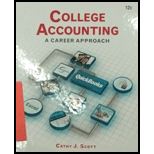
What is the term used for the profit on a sale before any operating expenses have been deducted?
- a. Net Income
- b. Net Profit
- c. Gross Profit
- d. Gain on Sale
- e. All of the above
Find the correct option that indicates the correct term for the given explanation.
Answer to Problem 1QY
The correct answer is option (c).
Explanation of Solution
Gross profit: Gross profit is the amount of revenue earned from goods sold over the costs incurred for the goods sold.
Formula to compute gross profit:
Justification for correct answer: Gross profit is the difference between net sales and cost of goods sold. The amount of cost of merchandise sold during a certain period is referred to as cost of goods sold. Cost of goods sold does not include any operating expenses. So, gross profit is the revenue generated from sales over the cost of goods sold, before any operating expenses are incurred. Hence, option (c) is correct.
Justification for incorrect answers:
- Option (a) is incorrect because net income is the difference between total revenues and total expenses of a business.
- Option (b) is incorrect because net income or net profit is the difference between total revenues and total expenses of a business.
- Option (d) is incorrect because gain on sale is the amount realized on sale transaction, when the sale proceeds is more than the book value of the asset on the date of sale.
- Option (e) is incorrect because option (c) is the correct answer and the phrase ‘all of the above’ is incorrect.
Therefore, option (c) is correct answer.
Want to see more full solutions like this?
Chapter 12 Solutions
College Accounting (Book Only): A Career Approach
Additional Business Textbook Solutions
Financial Accounting, Student Value Edition (5th Edition)
Marketing: An Introduction (13th Edition)
Gitman: Principl Manageri Finance_15 (15th Edition) (What's New in Finance)
Principles of Operations Management: Sustainability and Supply Chain Management (10th Edition)
Intermediate Accounting (2nd Edition)
Horngren's Accounting (12th Edition)
- How is the cost of goods sold (COGS) calculated? Explanation.arrow_forwardDie Industries began operations on March 1 with cash of $150,000. All of March's $240,000 sales were on account. During March, no customer collections occurred. The cost of goods sold was $95,000, and there were no ending inventories or accounts payable. Use this information to determine the ending balance of cash on hand for March.arrow_forwardWhat is Redmont enterprise total equity ?arrow_forward
 College Accounting (Book Only): A Career ApproachAccountingISBN:9781337280570Author:Scott, Cathy J.Publisher:South-Western College Pub
College Accounting (Book Only): A Career ApproachAccountingISBN:9781337280570Author:Scott, Cathy J.Publisher:South-Western College Pub College Accounting, Chapters 1-27AccountingISBN:9781337794756Author:HEINTZ, James A.Publisher:Cengage Learning,Principles of Accounting Volume 1AccountingISBN:9781947172685Author:OpenStaxPublisher:OpenStax College
College Accounting, Chapters 1-27AccountingISBN:9781337794756Author:HEINTZ, James A.Publisher:Cengage Learning,Principles of Accounting Volume 1AccountingISBN:9781947172685Author:OpenStaxPublisher:OpenStax College- Century 21 Accounting Multicolumn JournalAccountingISBN:9781337679503Author:GilbertsonPublisher:Cengage
 Cornerstones of Financial AccountingAccountingISBN:9781337690881Author:Jay Rich, Jeff JonesPublisher:Cengage Learning
Cornerstones of Financial AccountingAccountingISBN:9781337690881Author:Jay Rich, Jeff JonesPublisher:Cengage Learning





